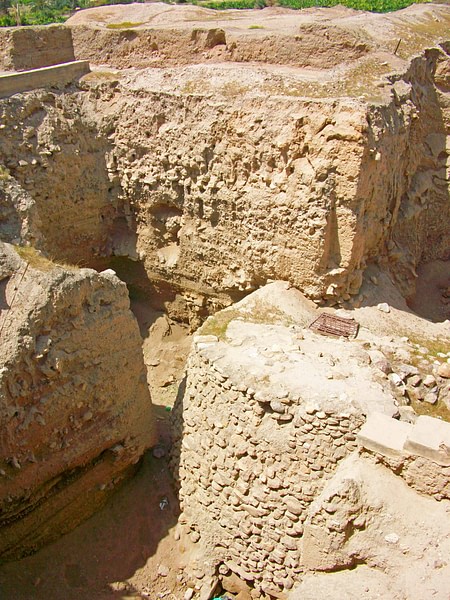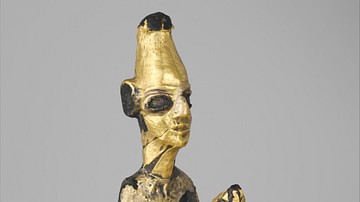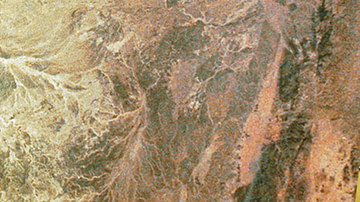The city of Jericho is remembered for the story in the Book of Joshua in the Bible regarding its destruction by the Israelites. Excavations have revealed that Jericho is one of the earliest settlements dating back to 9000 BCE. It also has the oldest known protective wall in the world. Continuing excavations have revealed stone towers which are even older. The reason for its earliest settlements are the springs which are found in and near the city. These springs supply the area with enough water to sustain a large population. We are going to cover the settlement of Jericho from its earliest beginnings until The Battle of Jericho in the Bible.
First Settlement
Jericho started as a popular camping ground for the hunter-gathers of the Natufian culture dating to 10000 BCE. It wasn't until the cold and drought caused by the last Ice Age, or Younger Dryas, came to an end around 9600 BCE that year-round habitation and permanent settlements began in the area. Tell es-Sultan (Sultan's Hill), 2 kilometers (1.2 miles) north of modern-day Jericho, became the earliest permanent settlement. It was a Pre-Pottery Neolithic (New Stone Age) settlement. It is situated on the Ein as-Sultan spring (later called Elisha's Spring) supplying it with water. By about 9400 BCE the settlement grew to include more than 70 homes. These circular dwellings measured 5 meters (16 feet) in diameter and were built with clay and straw.
The Wall of Jericho
Archaeological evidence reveals that by 8000 BCE, the site grew to 40,000 square meters (430,000 square feet) and was surrounded by a stone wall 3.6 meters (11.8 feet) high and 1.8 meters (5.9 feet) wide at the base. Inside the wall was a stone tower 8.5 meters (28 feet) high and 9 meters (30 feet) wide at the base. The tower had an internal staircase with 22 steps. The only older towers than this one have been found at Tell Qaramel in Syria. It is thought that the wall was used to protect the settlement from flood waters. The tower was used for ceremonial purposes. This suggests that there was a social organization happening in the town. Some scholars believe that the tower was used to motivate people into taking part in the communal lifestyle. Estimates vary on the population with a low of 300 to a high of 3000. At this time the inhabitants domesticated wheat, barley and legumes. It is highly probable that irrigation had been invented to provide enough land for the cultivation of these crops. They supplemented their diet by hunting wild animals.

The Second Settlement
After a few centuries, the first settlement was abandoned. Around 7000 BCE, a second settlement was established by an invading people that absorbed the original inhabitants into their culture. It too was a Pre-Pottery Neolithic settlement. This new settlement expanded the range of domesticated plants. There is evidence for the possible domestication of sheep at this time. Buildings were rectilinear structures made of mudbricks. Each building consisted of several rooms situated around a central courtyard. The rooms had terrazzo floors made of lime and the courtyard had a floor made of clay. Other advancements include flints in the shape of arrowheads, sickle blades, burins (used as chisels), scrapers, and axes. Also found were grindstones, hammerstones, and axes made of greenstone. Dishes and bowls were carved from soft limestone. The greatest distinction of this culture was that they kept the heads of deceased relatives by plastering the skulls and painting the features of the person on it. These skulls were kept in the home and the rest of the body was buried. This settlement lasted until about 6000 BCE. There is then little evidence of occupation at Jericho for at least 1000 years.
Bronze Age & The Fall of Jericho
After this, new settlements were established in Jericho periodically. These settlements were still Neolithic, but there is evidence that they were producing pottery. It became a walled town again at the end of the 4th millennium BCE. Evidence shows that the walls have been rebuilt many times. The largest of these settlements was constructed in 2600 BCE by the Amorites. About 2300 BCE, there was once more a break in the occupation of the site. It was taken over by the Canaanites in 1900 BCE and reached its greatest prominence between 1700 BCE and 1550 BCE. This was due to the rise of aristocrats that utilized chariots called the Maryannu in the Mitannite state to the north. Their rise caused a greater urbanization in the surrounding area, including Jericho. By this time, there were two walls around the city in a double enclosure made of mud brick. The outside wall rested on top of a stone base. Though they were impressive in size, they were not stable. Bronze Age Jericho fell in the 16th century around 1573 BCE when it was violently destroyed by an earthquake. Charred wood found at the site suggests that the remains of the city were burned. Buried food supplies also suggest that it was not captured following a siege. It remained unoccupied until the late 10th century or early 9th century BCE when it was rebuilt.

The Israelites & The Battle of Jericho
According to the Bible, at around 1,400 BCE, Jericho was the first city attacked by the Israelites after they crossed the Jordan River and entered Canaan. The Wall of Jericho was destroyed when the Israelites walked around it for seven days carrying the Ark of the Covenant. On the seventh day, Joshua commanded his people to blow their trumpets made of rams' horns and shout at the walls until they finally fell down. Excavations of the site reveal a network of collapsed walls that date to around the late 17th century or early 16th century BCE. The most likely cause of the collapse was an earthquake. Descriptions of later earthquake destruction (1267 CE & 1927 CE) match the description of the collapsed walls in the Bible. In each description, the cliffs above the Jordan River fell into the river and dammed it up. It also reveals that Jericho was unoccupied from the late 15th century to around the 10th century BCE. Non-Biblical Scholars now believe that the Bible story is an allegory. The story was written sometime after 722 BCE, long after the date of the event, and was used to claim the territory for the Kingdom Of Israel. Biblical Scholars point to the destruction of the walls 175 years earlier as proof that the story in the Bible is true. They state that the only thing amiss is the dating in the Bible and that the earthquake was God rewarding the Israelites for following his commands. According to the Bible, Jericho remained abandoned until Hiel the Bethelite established himself there in the 9th century BCE.










